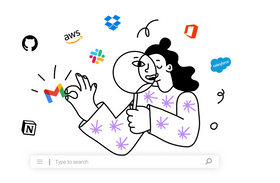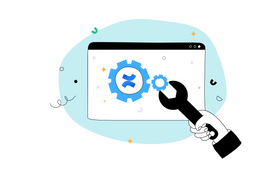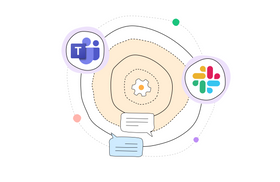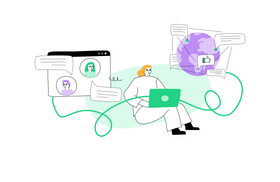Enterprise Knowledge Graphs: Benefits and Use Cases
Published April 3, 2023.
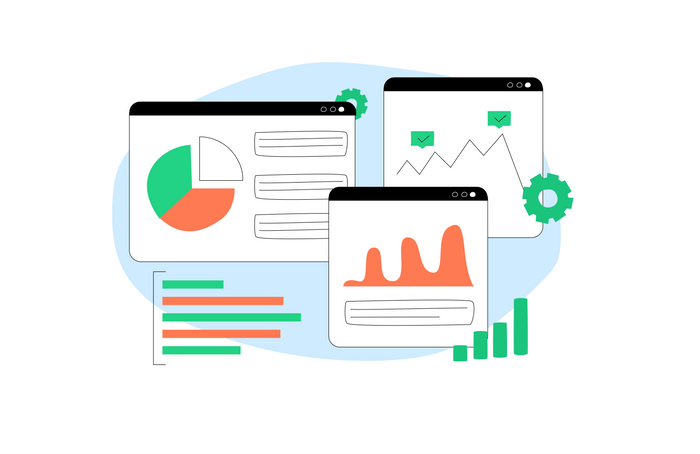
An enterprise knowledge graph is an incredibly valuable tool for any organization but is also heavily underutilized.
But what is a knowledge graph?
Also known as a semantic network, a knowledge graph is used to illustrate connections between siloed data and visualize the underlying connection between the data. It represents a network of real-world entities—objects, events, situations, or concepts—and highlights their relationships.
This knowledge graph, or visual representation of an organization’s knowledge domain and artifacts, can then be read by both machines and humans.
A knowledge graph lets organizations make strategic decisions, considering it connects all data into an artificial brain, allowing business owners to improve their decision-making skills.
Benefits of Knowledge Graphs
Let’s take a look at some of the key benefits of knowledge graphs:
Easy Availability
Organizations today are bombarded with a staggering amount of data. One of the advantages of a knowledge graph is that it allows you to sort through this data and find relationships between different data points.
Enterprise knowledge graphs can help businesses make their data available across all organizational teams to collaborate and gather insights.
Improved Integration
When dealing with a vast array of constantly changing data, it can be challenging for an organization to extract context from this information. A knowledge graph can help here. They can extract entities and context from constantly evolving datasets and figure out exactly where to fit the entity in a graph.
Once a knowledge graph is programmed, it automatically responds to data changes and updates the knowledge base. This saves companies time from having to reprogram a knowledge graph after every change.
Knowledge Flow Visualization
A knowledge graph creates a data network that allows organizations to get an accurate visual representation of the flow of facts between entities.
Since knowledge graphs can show information visually, corporations can find problematic areas, reveal hidden risks, or discover new patterns in data. This makes following business workflows much easier.
Faster Decision-Making
Organizations could save a lot of time by skipping broader searches and narrowing information down to desired solutions. This is where knowledge graphs come in. By providing an overall picture of business knowledge, organizations can get the most value from their gathered data in the shortest possible time. A knowledge graph can also provide relevant facts and contextualized answers to smoothen the decision-making process further.
✶ Learn how to overcome the dangers of knowledge hoarding
Uses of Enterprise Knowledge Graphs
There are plenty of knowledge graph use cases, and several industries can benefit from them. These graphs can help, for example, in fraud detection, providing accurate product recommendations, and easing search processes. Considering the variety of uses on offer, a knowledge graph can be helpful in several types of corporate systems.
Finance
The finance industry has used the benefits offered by a knowledge graph for several years to lead many essential projects. They can help prevent financial crimes, such as money laundering and fraud, and even help investigate them.
A knowledge graph can help banks and other financial institutions monitor the flow of money across their customer base and identify customers that are non-compliant. It’s also been used to plan out know-your-customer (KYC) initiatives.
Retail
Product design, development, and marketing are critical aspects of the success of any retail brand. Since a knowledge graph can help marketers understand customer behavior better, it can help create more powerful, targeted marketing campaigns. It can also help an organization understand basic product flaws and provide useful information on designing these products better.
A knowledge graph can also be used to recommend products based on previous customer behavior and popular trends across demographic groups.
Searches
Most tech companies and service-based businesses use knowledge graphs for the immense search-related benefits they offer. Knowledge graphs can help improve the efficiency of user queries by getting behind the true meanings of search terms and representing the layers of connections between separate data.
A search powered by a semantic knowledge graph is often called a “semantic search.” Among its uses, a semantic knowledge graph opens up readily-available data sources for journalistic purposes and can help expand user queries by using keywords to identify trending topics.
Unleashing the Power of Enterprise Knowledge Graphs
An enterprise knowledge graph and its semantic search capabilities offer various benefits to any organization, from speeding up the decision-making progress to understanding the relationship between large amounts of data.
A knowledge graph can help ease the process of searching. But that’s not all that can help. To further improve your search experience, we encourage you to try the tools offered by Unleash.
One of the top enterprise searches, as attested to by leading experts, Unleash uses GPT-powered answers to respond to even the most vaguely worded queries. Plus, it’s easy to use, searches every folder and application in detail, and helps a business streamline productivity.
✶ Get your own knowledge graph with Unleash
